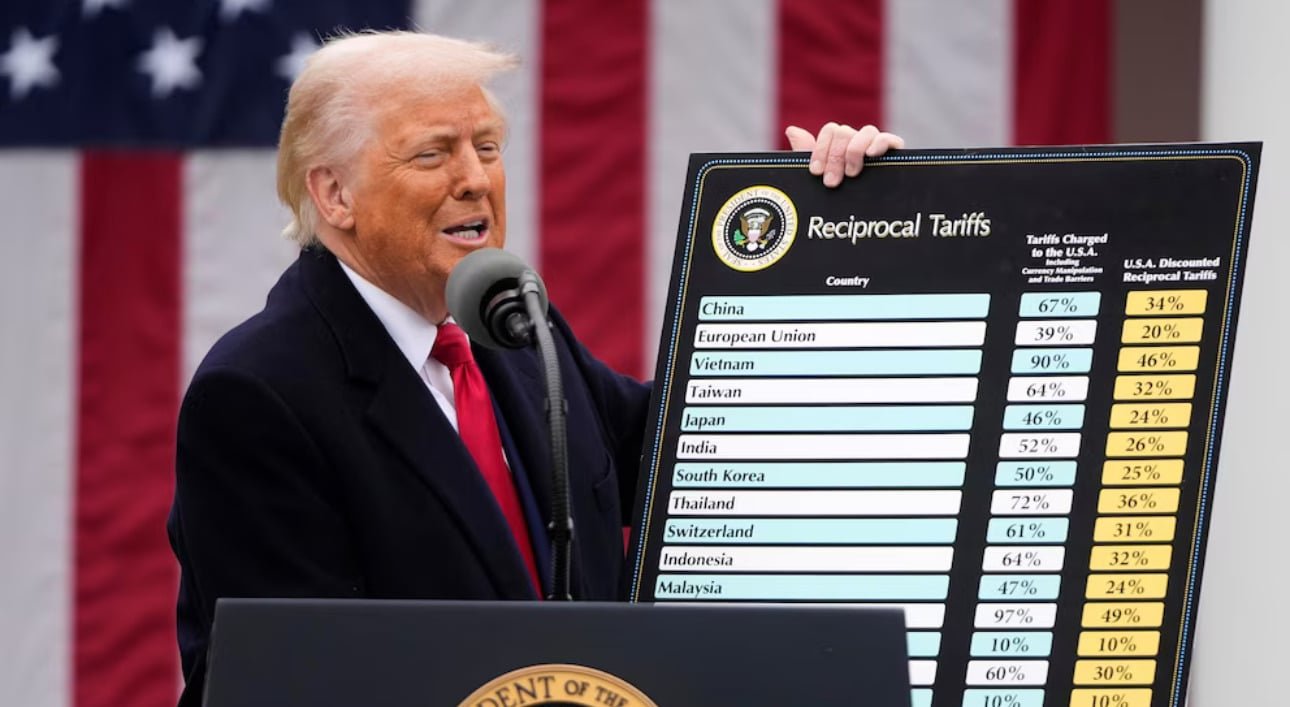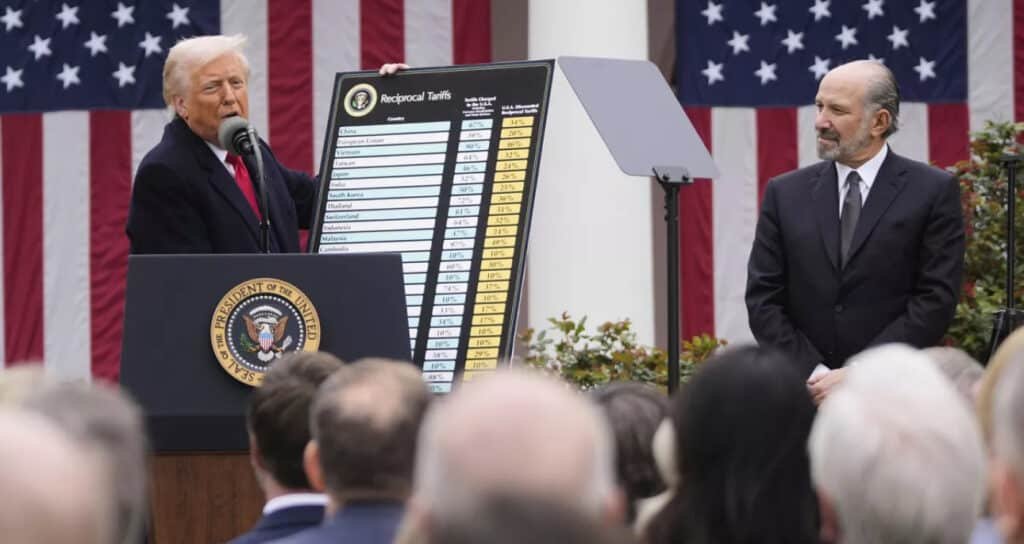BREAKING: Trump’s New Tariff Plan: A Closer Look 4/4/25
President Donald Trump announced his multi-tiered tariff strategy on Wednesday which his administration celebrated as “Liberation Day” while promising to revive the American dream.
President Donald Trump revealed new tariff measures during a White House Rose Garden ceremony for a “Make America Wealthy Again” event where he stated these measures would create numerous jobs for American workers.
President Trump stated Wednesday that their response to unfair treatment by other nations will include calculating all their tariffs, nonmonetary barriers and cheating methods.
He informed us that they would be charged roughly half of their current charges because we are extending our kindness. The implemented tariffs will not mirror full reciprocity. I could have done that. Yes. A number of countries would have faced significant difficulties under such terms.
All imports into the United States face a 10% baseline duty under the Trump administration’s tariff plan which also includes customized tariffs for nations that maintain higher tariffs on American products. 10% baseline tariffs start on Saturday with other tariffs following on April 9.
The Trump administration enacted a 25% tariff on imported vehicles together with maximum 25% duties on select products from Mexico and Canada and a 20% tariff on Chinese shipments. Existing tariffs imposed on Canada and Mexico will continue unchanged according to White House officials. Additional tariffs on China will be implemented alongside the current Beijing duties.
Key Takeaways
- Trump’s new tariffs target various imports, aiming to support U.S. manufacturing.
- Trade deficits are a primary focus of this plan, particularlly concerning China.
- The tariffs have sparked a possible trade war, causing reactions from global partners.
- Economic experts warn of rising consumer prices and inflationary pressures.
- The average U.S. tariff rate is projected to reach its highest point in over a century.
- Bipartisan concern in Congress indicates significant domestic and international ramifications.
Overview of Trump’s New Tariff Plan
Understanding Trump’s new tariff plan is key in today’s changing economy. It shows how tariffs help American businesses and keep jobs here. We’re going back to values that support making things in America and fair trade.
Introduction to Tariff Implementation
The Trump administration’s tariff plan is changing the U.S. economy. Tariffs on certain imports aim to stop unfair trade and boost manufacturing. This plan wants to make global trade better for American companies and workers.
Historical Context of Tariffs Under Trump
Tariffs under Trump have targeted trade rivals, like China. These tariffs have changed trade balances and sparked debates. Knowing this history helps us understand what the new plan might bring.
Goals of the New Tariff Plan
The new tariff plan has big goals. It aims to cut trade deficits, ensure fair trade, and make American products more competitive. This plan shows our dedication to protecting American values and growing a strong economy for everyone.
Trump’s New Tariff Plan – A Closer Look
It’s important to understand Trump’s new tariff plan to see how it might affect our economy. A detailed look shows a focused approach on key sectors for American growth. This part will break down tariff rates and categories, list products with new tariffs, and show how tariffs will help fund domestic projects.
Detailed Analysis of Tariff Rates and Categories
The new tariffs target several key areas, with rates changing based on product type. Steel and aluminum face big hikes, while tech products see changes too. These rates will change costs in these sectors and affect competition.
Specific Products Targeted by the New Tariffs
Our study points out specific products hit by these tariffs. High-tech gadgets, car parts, and farm goods are main targets. These products will impact markets and how people buy things, as costs go up in supply chains.
Expected Revenue Generation from the Tariffs
The money from tariffs is key for funding domestic projects. A detailed financial plan shows big money for the government. This money will help fix roads and support public services, making America more competitive and stable.
| Product Category | Current Tariff Rate | Projected Revenue ($ Billion) |
|---|---|---|
| Steel | 25% | 10 |
| Aluminum | 10% | 5 |
| Consumer Electronics | 15% | 7.5 |
| Automotive Components | 20% | 8 |
| Agricultural Products | 5% | 3 |
This table shows the products hit by new tariffs and expected revenue. It gives a clear view of Trump’s tariff plan’s economic effects.
Impacts of Trump’s Tariff Plan on the Economy
Trump’s tariff plan affects many parts of the American economy. We need to look at how it might change economic growth, jobs, and prices. It’s important to understand how these changes affect us as a nation.
Potential Economic Growth or Contraction
New tariffs might help some American industries grow. They make imported goods more expensive, which could boost demand for American products. But, this could hurt other sectors that struggle to adapt.
Effects on Job Creation and Manufacturing
Tariffs could create more jobs and help manufacturing grow. They might lead to more hiring in factories and a focus on American-made goods. Yet, some industries might lose jobs while they adjust to the new tariffs.
Consumer Price Implications
We should watch out for how tariffs affect prices. Higher tariffs could make many goods more expensive, impacting our budgets. It’s key to protect American jobs without raising prices too much.
Global Trade Repercussions and US Trade Relations Under Trump
The recent changes in tariff policies have changed the game in international trade. This shift has big effects on global trade, as countries figure out how to react. We look at how these changes impact international relations and how the US protects its interests abroad.
Assessment of Impacts on International Relations
Imposing tariffs has caused tension and changed how the US trades under Trump. Countries with good trade deals before now think twice. This has led to changes in alliances and partnerships, showing how trade policy affects diplomacy.
Reactions from Key Trading Partners
Trading partners like China and the European Union have taken steps to protect their economies. Their actions show how global markets are connected and how countries adapt to new tariffs. They’re not just reacting; they’re planning to lessen the blow and stay strong.
Trade War Analysis and Long-term Consequences
The ongoing trade wars show tariffs’ double role: protection and retaliation. Knowing this helps us see the long-term effects, like changes in supply chains and consumer habits. As things change, so will global influence and power balances.
| Trading Partner | Initial Reaction | Countermeasure Strategy | Projected Outcome |
|---|---|---|---|
| China | Increased tariffs on US goods | Diversification of import sources | Stabilization of market shares |
| European Union | Retaliatory tariffs on select US imports | Negotiating new trade agreements | Realignment of trade flows |
| Canada | Defensive tariffs | Strengthening local industries | Enhanced domestic production |
Conclusion
President Trump’s new tariff plan is a big deal for American trade policy. It aims to make our country more independent and boost our economy. But, the effects of Trump’s tariffs are a big worry.
The tariffs are set to be higher than any before, even the Smoot-Hawley Act. This could lead to trade wars and hurt our economy. It’s a risk we can’t ignore.
This plan tries to help American businesses, but it’s causing problems. Jobs are being lost because of higher costs. Companies like Cleveland-Cliffs have already laid off workers.
Tariffs can’t solve all our economic problems or make us safer. Global trade is too complex for simple solutions. We need a smarter way to handle it.
As we look at this trade policy, we see public support fading. Even some Republicans are unhappy with rising prices and job losses. We must carefully check if this plan really helps America.
FAQ
What are the primary goals of Trump’s new tariff plan?
Trump’s new tariff plan aims to cut down trade deficits. It also wants fair trade and to make American products better than foreign ones. This is to protect American jobs and industries.
How will the new tariffs impact consumer prices?
The new tariffs might make some products more expensive. But, the goal is to help American manufacturing and jobs. This is to keep American buying power strong.
Which sectors are most affected by the new tariffs?
The new tariffs hit sectors like steel, aluminum, and technology hard. Specific rates for these areas aim to boost domestic production.
What historical context should be considered regarding tariffs under Trump?
Trump’s tariffs on China in his first term changed trading dynamics. They sparked debates on their effectiveness and economic impact.
How do these tariffs aim to bolster domestic manufacturing?
These tariffs make imported goods pricier. This encourages people to buy American-made products. It boosts demand for local production.
What are the expected revenue generation outcomes from these tariffs?
The tariffs are expected to bring in a lot of money. This money can fund important domestic programs and investments. It helps keep America economically strong.
What are the expected effects on job creation within the manufacturing sector?
These tariffs could create more jobs in manufacturing. This is because American products might see more demand due to less foreign competition.
How might international relations shift due to Trump’s tariff plan?
Trump’s tariff plan might change how countries trade with each other. Trading partners might respond with their own trade strategies or countermeasures.
What is the significance of the ongoing trade war related to these tariffs?
The ongoing trade war shows the big impact of Trump’s tariffs. It highlights both past lessons and future effects on America’s trade environment.















